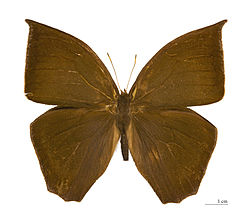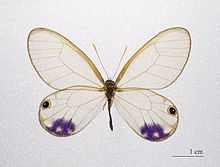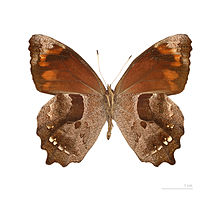- Satyrinae
-
 Satyrinae
Satyrinae
Taygetis excavata - Muséum de Toulouse Classification Règne Animalia Embranchement Arthropoda Classe Insecta Super-ordre Endopterygota Ordre Lepidoptera Sous-ordre Ditrysia Super-famille Papilionoidea Famille Nymphalidae Sous-famille Satyrinae
Boisduval, 1833 Retrouvez ce taxon sur Wikispecies
Retrouvez ce taxon sur Wikispecies
D'autres documents multimédia
sont disponibles sur CommonsLa sous-famille des Satyrinae regroupe des insectes lépidoptères de la famille des Nymphalidae.
Sommaire
Liste des tribus
Selon ITIS (21 avr. 2010)[1] :
- tribu Elymniini Herrich-Schäffer, 1864
- tribu Satyrini Boisduval, 1833
Selon NCBI (21 avr. 2010)[2] :- tribu Amathusiini
- tribu Brassolini
- tribu Dirini
- tribu Elymniini
- tribu Haeterini
- tribu Melanitini
- tribu Morphini
- tribu Satyrini
- tribu Zetherini
Liste des genres
Selon [réf. nécessaire] :
- Acrophtalmia (C. et R. Felder, 1861)
- Acropolis (Hemming, 1934)
- Admiratio (Hemming, 1964)
- Aeropetes (Billberg, 1820)
- Altiapa (Parsons, 1986)
- Altopedaliodes (Forster, 1964)
- Amphidecta (Butler, 1867)
- Apexacuta (Pyrcz, 2004)
- Aphantopus (Wallengren, 1853)
- Aphysoneura (Karsch, 1894)
- Archaeoeuptychia (Forster, 1964)
- Arethusana (de Lesse, 1951)
- Argestina (Riley, 1923)
- Argynnina (Butler, 1867)
- Argyronympha (Mathew, 1886)
- Argyrophenga (Doubleday, 1845)
- Argyrophorus (Blanchard, 1852)
- Arhauco (Adams et Bernard, 1977)
- Atercoloratus (Bang-Haas, 1938)
- Auca (Hayward, 1953)
- Aulocera (Butler, 1867)
- Austroypthima (Holloway, 1974)
- Berberia (de Lesse, 1951)
- Bicyclus (Kirby, 1871)
- Bletogona (C. et R. Felder, 1867)
- Boerebia (Prout, 1901)
- Brintesia (Fruhstorfer, 1911)
- Calisto (Hübner, 1823)
- Callarge (Leech, 1892)
- Callerebia (Butler, 1867)
- Capronnieria (Forster, 1964)
- Carminda (Ebert et Dias, 1997)
- Cassionympha (van Son, 1955)
- Catargynnis (Röber, 1892)
- Cercyeuptychia (Miller et Emmel, 1971)
- Cercyonis (Scudder, 1875)
- Chazara (Moore, 1893)
- Cheimas Thieme, 1907)
- Chillanella (Herrera, 1966)
- Chloreuptychia (Forster, 1964)
- Chonala (Moore, 1893)
- Cissia (Doubleday, 1848.
- Cithaerias (Hübner, 1819)
- Coelites (Westwood, 1850)
- Coenonympha (Hübner, 1819)
- Coenoptychia (Le Cerf, 1919)
- Coenyra (Hewitson, 1865)
- Coenyropsis (van Son, 1958)
- Coeruleotaygetis (Forster, 1964)
- Corades (Hewitson, 1849)
- Cosmosatyrus (C. et R. Felder, 1867)
- Cyllogenes (Butler, 1868)
- Cyllopsis (Felder, 1869)
- Daedalma (Hewitson, 1858)
- Dangond (Adams et Bernard, 1979)
- Davidina (Oberthür, 1879)
- Diaphanos (Adams et Bernard, 1981)
- Dingana (van Son, 1955)
- Dira (Hübner, 1819)
- Dodonidia (Butler, 1884)
- Drucina (Butler, 1872)
- Dulcedo (d'Almeida, 1951)
- Elina (Blanchard, 1852)
- Elymnias (Hübner, 1818)
- Enodia (Hübner, 1819)
- Erebia (Dalman, 1816)
- Erebina (Bryk, 1944)
- Erebiola (Fereday, 1879)
- Eretris (Thieme, 1905)
- Erichthodes (Forster, 1964)
- Erites (Westwood, 1851)
- Erycinidia (Rothschild et Jordan, 1905)
- Esperarge (Nekrutenko, 1988; non invalide synonyme Kirinia (Moore, 1893)
- Etcheverinus
- Eteona (Doubleday, 1848)
- Ethope (Moore, 1866)
- Euptychia Hübner, 1818)
- Euptychoides (Forster, 1964)
- Faunula (C. et R. Felder, 1867)
- Forsterinaria (Gray, 1973)
- Geitoneura (Butler, 1867)
- Gnophodes (Doubleday, 1849)
- Godartiana (Forster, 1964)
- Gyrocheilus (Butler, 1867)
- Haetera (Fabricius, 1807)
- Hallelesis (Condamin, 1961)
- Hanipha (Moore, 1880)
- Harjesia (Forster, 1964)
- Harsiesis (Fruhstorfer, 1911)
- Haywardella (Herrera, 1966)
- Henotesia (Butler, 1879)
- Hermeuptychia (Forster, 1964)
- Heteronympha (Wallengren, 1858)
- Heteropsis (Westwood, 1850)
- Hipparchia (Fabricius, 1807)
- Homoeonympha (C. et R. Felder, 1867)
- Houlbertia (Oberthür, 1916)
- Hyalodia (Jordan, 1924)
- Hypocysta (Westwood, 1851)
- Hyponephele (Muschamp, 1915)
- Idioneurula (Strand, 1932)
- Junea (Hemming, 1964)
- Kanetisa (Moore, 1893)
- Karanasa (Moore, 1893)
- Kirinia (Moore, 1893)
- Lamprolenis (Godman et Salvin, 1881)
- Lasiommata (Westwood, 1841)
- Lasiophila (C. et R. Felder, 1859)
- Lethe (Hübner, 1819)
- Lopinga (Moore, 1893)
- Loxerebia (Watkins, 1925)
- Lyela (Swinhoe, 1908)
- Lymanopoda (Westwood, 1851)
- Magneuptychia (Forster, 1964)
- Manataria (Kirby, 1904)
- Mandarinia (Leech, 1892)
- Manerebia (Staudinger, 1897)
- Maniola (Schrank, 1801)
- Mashuna (van Son, 1955)
- Masoura (Hemming, 1964)
- Megeuptychia (Forster, 1964)
- Megisto (Hübner, 1819)
- Melampias (Hübner, 1819)
- Melanargia (Meigen, 1828)
- Melanitis (Fabricius, 1807)
- Minois Hübner, 1819)
- Moneuptychia Forster, 1964)
- Mycalesis Hübner, 1818)
- Mygona (Thieme, 1907)
- Neita (van Son, 1955)
- Nelia (Hayward, 1953)
- Neocoenyra (Butler, 1886)
- Neomaenas (Wallengren, 1858)
- Neominois (Scudder, 1875)
- Neonympha (Hübner, 1818)
- Neope (Moore, 1866)
- Neorina (Westwood, 1850)
- Neosatyrus (Wallengren, 1858)
- Nesoxenica (Waterhouse et Lyell, 1914)
- Ninguta (Moore, 1892)
- Nirvana (Tsukada et Nishiyama, 1979)
- Nosea (Koiwaya, 1993)
- Oeneis (Hübner, 1819)
- Oreixenica (Waterhouse et Lyell, 1914)
- Oressinoma (Doubleday, 1849)
- Orinoma (Gray, 1846)
- Orsotriaena (Wallengren, 1858)
- Oxeoschistus (Butler, 1867)
- Palaeonympha (Butler, 1871)
- Palmaris (Herrera, 1965)
- Pampasatyrus (Hayward, 1953)
- Pamperis (Heimlich, 1959)
- Panyapedaliodes (Forster, 1964)
- Parahipparchia (Kurdna, 1977)
- Paralasa (Moore, 1893)
- Paralethe (van Son, 1955)
- Paramacera (Butler, 1868)
- Paramo (Adams et Bernard, 1977)
- Parantirrhoea (Wood-Mason, 1881)
- Parapedaliodes (Forster, 1964)
- Pararge (Hübner, 1819)
- Paratisiphone (Watkins, 1928)
- Paroeneis (Moore, 1893)
- Parypthimoides (Forster, 1964)
- Pedaliodes (Butler, 1867)
- Penthema (Doubleday, 1848)
- Percnodaimon (Butler, 1876)
- Physcaeneura (Wallengren, 1857)
- Physcopedaliodes (Forster, 1964)
- Pierella (Herrich-Schäffer, 1865)
- Pieridopsis (Rothschild et Jordan, 1905.
- Pindis (Felder, 1869.
- Platypthima (Rothschild et Jordan, 1905.
- Praefaunula (Forster, 1964.
- Praepronophila (Forster, 1964.
- Proboscis (Thieme, 1907.
- Pronophila (Doubleday, 1849.
- Proterebia (Roos et Arnschied, 1980.
- Protopedaliodes (Viloria et Pyrcz, 1994.
- Pseudeuptychia (Forster, 1964.
- Pseudocercyonis (Miller et Emmel, 1971.
- Pseudochazara (de Lesse, 1951.
- Pseudohaetera (Brown, 1942.
- Pseudomaniola (Weymer, 1890.
- Pseudomycalesis (Tsukada et Nishiyama, 1979.
- Pseudonympha (Wallengren, 1857.
- Ptychandra (C. et R. Felder, 1861.
- Punapedaliodes (Forster, 1964.
- Punargenteus (Heimlich, 1963.
- Pyronia (Hübner, 1819.
- Ragadia (Westwood, 1851.
- Rareuptychia (Forster, 1964.
- Redonda (Adams et Bernard, 1981.
- Rhaphicera (Butler, 1867.
- Satyrodes (Scudder, 1875.
- Satyrus (Latreille, 1810.
- Setodocis (Billberg, 1820.
- Sierrasteroma (Adams et Bernard, 1977.
- Sinonympha (Lee, 1974.
- Splendeuptychia (Forster, 1964.
- Steremnia (Thieme, 1905.
- Steroma (Westwood, 1850.
- Steromapedaliodes (Forster, 1964.
- Strabena (Mabille, 1877.
- Stuardosatyrus (Herrera et Etcheverry, 1965.
- Stygionympha (van Son, 1955.
- Stygnolepis (Strand, 1942.
- Tamania (Prycz, 1995.
- Tarsocera (Butler, 1899.
- Tatinga (Moore, 1893.
- Taydebis (Freitas, 2003.
- Taygetis (Hübner, 1819.
- Tetraphlebia (C. et R. Felder, 1867.
- Thiemeia (Weymer, 1912.
- Tisiphone (Hübner, 1819.
- Torynesis (Butler, 1899.
- Triphysa (Zeller, 1850.
- Vareuptychia (Forster, 1964.
- Weymerana (Forster, 1964.
- Yphthimoides (Forster, 1964.
- Ypthima (Hübner, 1818.
- Ypthimomorpha (van Son, 1955.
- Zethera (Felder, 1861.
- Zipaetis (Hewitson, 1863.
- Zischkaia (Forster, 1964.
Selon ITIS (21 avr. 2010)[1] :- tribu Elymniini Herrich-Schäffer, 1864
- sous-tribu Lethina Reuter, 1896
- genre Lethe Hübner, 1819
- sous-tribu Lethina Reuter, 1896
- tribu Satyrini Boisduval, 1833
- sous-tribu Coenonymphina Tutt, 1896
- genre Coenonympha Hübner, 1819
- sous-tribu Erebiina Tutt, 1896
- genre Erebia Dalman, 1816
- sous-tribu Euptychiina Reuter, 1896
- sous-tribu Maniolina Verity, 1953
- genre Cercyonis Scudder, 1875
- sous-tribu Pronophilina Reuter, 1896
- genre Gyrocheilus Butler, 1867
- sous-tribu Satyrina Boisduval, 1833
- sous-tribu Coenonymphina Tutt, 1896
Selon NCBI (21 avr. 2010)[2] :- tribu Amathusiini
- genre Aemona
- genre Amathusia
- genre Amathuxidia
- genre Discophora
- genre Faunis
- genre Hyantis
- genre Stichophthalma
- genre Taenaris
- genre Thaumantis
- genre Thauria
- genre Xanthotaenia
- genre Zeuxidia
- tribu Brassolini
- genre Bia
- genre Brassolis
- genre Caligo
- genre Catoblepia
- genre Dasyophthalma
- genre Dynastor
- genre Narope
- genre Opoptera
- genre Opsiphanes
- tribu Dirini
- genre Aeropetes
- genre Dira
- genre Paralethe
- genre Tarsocera
- genre Torynesis
- tribu Elymniini
- genre Elymnias
- tribu Haeterini
- genre Cithaerias
- genre Haetera
- genre Pierella
- genre Pseudohaetera
- tribu Melanitini
- genre Cyllogenes
- genre Gnophodes
- genre Manataria
- genre Melanitis
- tribu Morphini
- sous-tribu Antirrheina
- genre Antirrhea
- genre Caerois
- sous-tribu Morphina
- genre Morpho
- sous-tribu Antirrheina
- tribu Satyrini
- sous-tribu Coenonymphina
- genre Coenonympha
- genre Lyela
- genre Sinonympha
- genre Triphysa
- sous-tribu Erebiina
- genre Erebia
- sous-tribu Eritina
- genre Coelites
- genre Erites
- sous-tribu Euptychiina
- genre Amphidecta
- genre Archeuptychia
- genre Caeruleuptychia
- genre Capronnieria
- genre Cepheuptychia
- genre Cercyeuptychia
- genre Chloreuptychia
- genre Cissia
- genre Coeruleotaygetis
- genre Cyllopsis
- genre Erichthodes
- genre Euptychia
- genre Euptychoides
- genre Forsterinaria
- genre Godartiana
- genre Guaianaza
- genre Harjesia
- genre Hermeuptychia
- genre Magneuptychia
- genre Megeuptychia
- genre Megisto
- genre Moneuptychia
- genre Neonympha
- genre Oressinoma
- genre Palaeonympha
- genre Paramacera
- genre Parataygetis
- genre Pareuptychia
- genre Paryphthimoides
- genre Pharneuptychia
- genre Pindis
- genre Posttaygetis
- genre Pseudodebis
- genre Rareuptychia
- genre Satyrotaygetis
- genre Splendeuptychia
- genre Taydebis
- genre Taygetis
- genre Taygetomorpha
- genre Yphthimoides
- genre Zischkaia
- sous-tribu Hypocystina
- genre Argynnina
- genre Argyronympha
- genre Argyrophenga
- genre Dodonidia
- genre Erebiola
- genre Erycinidia
- genre Geitoneura
- genre Harsiesis
- genre Heteronympha
- genre Hypocysta
- genre Lamprolenis
- genre Nesoxenica
- genre Oreixenica
- genre Paratisiphone
- genre Percnodaimon
- genre Platypthima
- genre Tisiphone
- genre Zipaetis
- sous-tribu Lethina
- genre Aphysoneura
- genre Enodia
- genre Lethe
- genre Neope
- genre Ninguta
- genre Satyrodes
- sous-tribu Maniolina
- genre Aphantopus
- genre Cercyonis
- genre Hyponephele
- genre Maniola
- jurtina species complex
- genre Proterebia
- genre Pyronia
- sous-tribu Melanargiina
- genre Melanargia
- sous-tribu Mycalesina
- genre Admiratio
- genre Bicyclus
- genre Hallelesis
- genre Henotesia
- genre Heteropsis
- genre Houlbertia
- genre Masoura
- genre Mycalesis
- genre Orsotriaena
- sous-tribu Parargina
- genre Chonala
- genre Kirinia
- genre Lasiommata
- genre Lopinga
- genre Pararge
- genre Rhaphicera
- genre Tatinga
- sous-tribu Pronophilina
- genre Altopedaliodes
- genre Apexacuta
- genre Argyrophorus
- genre Auca
- genre Calisto
- genre Cheimas
- genre Chillanella
- genre Corades
- genre Cosmosatyrus
- genre Daedalma
- genre Diaphanos
- genre Elina
- genre Eretris
- genre Etcheverrius
- genre Eteona
- genre Faunula
- genre Foetterleia
- genre Haywardella
- genre Ianussiusa
- genre Idioneurula
- genre Junea
- genre Lasiophila
- genre Lymanopoda
- genre Manerebia
- genre Mygona
- genre Nelia
- genre Oxeoschistus
- genre Pampasatyrus
- genre Panyapedaliodes
- genre Parapedaliodes
- genre Pedaliodes
- genre Praepedaliodes
- genre Proboscis
- genre Pronophila
- genre Pseudomaniola
- genre Punapedaliodes
- genre Punargentus
- genre Quilaphoetosus
- genre Redonda
- genre Steremnia
- genre Steroma
- genre Steromapedaliodes
- genre Tamania
- genre Thiemeia
- sous-tribu Ragadiina
- genre Acrophtalmia
- genre Ragadia
- sous-tribu Satyrina
- genre Arethusana
- genre Aulocera
- genre Berberia
- genre Boeberia
- genre Boerebia
- genre Brintesia
- genre Callerebia
- genre Cassionympha
- genre Chazara
- genre Hipparchia
- genre Karanasa
- genre Loxerebia
- genre Minois
- genre Neocoenyra
- genre Neohipparchia
- statilinus species complex
- genre Neominois
- genre Oeneis
- genre Paralasa
- genre Pseudochazara
- genre Pseudonympha
- genre Pseudotergumia
- genre Satyrus
- genre Strabena
- genre Stygionympha
- genre Ypthima
- genre Ypthimomorpha
- sous-tribu Coenonymphina
- tribu Zetherini
- genre Ethope
- genre Neorina
- genre Penthema
- genre Zethera
Notes et références
Liens externes
- Référence Tree of Life Web Project : Satyrinae (en)
- Référence Fauna Europaea : Satyrinae (en)
- Référence ITIS : Satyrinae Boisduval, 1833 (fr) ( (en))
- Référence Animal Diversity Web : Satyrinae (en)
- Référence NCBI : Satyrinae (en)
Wikimedia Foundation. 2010.



